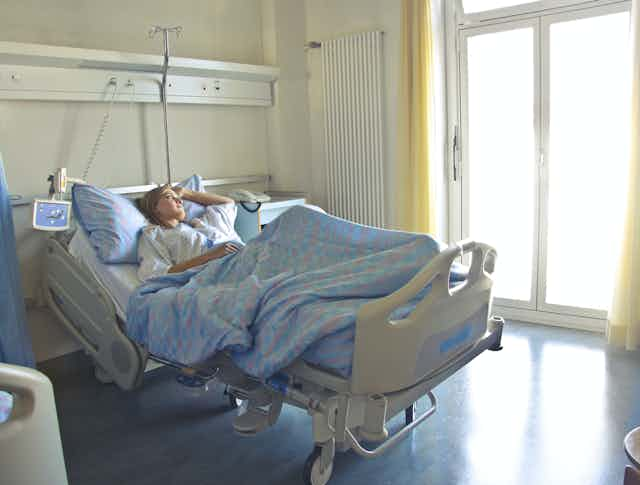The federal government has, for a long time, encouraged Australians to get private health insurance, in an attempt to reduce the financial burden on the public health system.
To make private health insurance more attractive, the government has a strategy of carrots and sticks. Low-income and older people receive subsidies through “premium rebates”. High-income earners without the right policy face the Medicare Levy Surcharge, ranging from 1 to 1.5% of their taxable income.
The effectiveness of these subsidies is regularly debated, with questions about whether the A$6.7 billion of taxpayer money that subsidises private health insurance premiums could be better spent on Medicare or directly financing hospitals.
We set out to answer this question: do the savings from increased participation in private health insurance outweigh the costs the government incurs by subsidising private health insurance rebates?
Our analysis, which was commissioned and funded by the Department of Health and Aged Care, found large benefits to the government, especially when older people sign up for private insurance. On average, the government saves about $554 for each person it helps with these subsidies a year.
But rebates can be better targeted for Australians who are more likely to need and use health services.
How did we work this out?
To assess if the money spent on subsidising private health insurance pays off, we examined both the costs (from the premium rebate subsidies and the forgone tax from the Medicare Levy Surcharge) and the savings.
To calculate the savings we looked at how much money the government would spend if these people didn’t have private health insurance and used the public health system instead of the private system. We call this the “offset”.
This is a key metric for the success of the carrot and sticks, as it will be able to tell us the health-care costs saved by the government when someone has private insurance.
Using private health insurance spending data from 2019, we made assumptions that one day in a private hospital costs equal to one day in a public hospital, based on findings from the Productivity Commission.
We also factored in the government’s 75% Medicare Benefits Schedule fee contribution, and higher prices for prostheses (for hip replacements and other implants) in the private system.
On average, we found that private health insurance offsets public health-care costs by about $1,400 per person, with greater savings for older people than younger people, reaching $4,000 for those aged 75 and above.
To answer if the savings from private insurance take-up outweighs the costs incurred, we needed to take into account what the government spends to subsidise insurance.
We used the standard premium rebate percentages where a person aged 70 or above earning up to $90,000 attracts a 32.812% rebate, while a person aged under 65 making $105,001–$140,000 would receive a 8.202% rebate.

With an average annual private health insurance premium of $2,300, this would mean the government incurs costs ranging from $755 to $189.
As people who enrol in private insurance don’t have to pay the Medicare Levy Surcharge, which helps fund the public health system, we found that the forgone tax amounts range between $970 and $2,400 for single individuals subject to the penalty.
Combining the costs (from the premium rebate subsidies and the forgone tax from the Medicare Levy Surcharge), and subtracting the savings (the offsets), is how we find that the subsidies are a good financial deal for the government. The subsidies are less than the cost offset by about $554 per person who has private health insurance.
Is there room for improvement?
This raises a question: what if we could change these subsidies based on who costs more to provide health care for and who saves the government more money? As our findings reveal that some groups save the government more money than their subsidies cost, what should we do with the subsidies? If we increase their subsidies, it costs taxpayers more – unless more of them switch to private health insurance.
For instance, an individual aged 75+ earning $105,001 to $140,000 receives $1,877 in subsidies and offsets $5,268 in public health spending, saving the government $3,391. Given the roughly 6,000 people in this age group currently in private health insurance, only two additional enrolments would make it budget-neutral.
How can the savings be used?
A better way to subsidise private health insurance is to give extra subsidies to people who are sicker and need more medical care. These are known as “risk-adjusted subsidies”.
A risk-adjusted subsidy would be based on a person’s characteristics such as their age, gender, income, where they live and their health history (such as prior hospitalisations, or use of services). These are people who need private health insurance the most, and also would save the government the most money by having private insurance.
This subsidy could be computed by a formula that uses individual-level spending to figure out how much health care the person is likely to need and how much it’s expected to cost.
Existing work in Australia has shown how this can be developed, while countries such as the Netherlands, Germany, the United States and Switzerland show such a system is feasible.
The Australian health system, and private health insurance regulation in particular, is set for a shake-up, with the Department of Health and Aged Care seeking input on its options. Our research can help inform a path forward.
Read more: Who really benefits from private health insurance rebates? Not people who need cover the most

